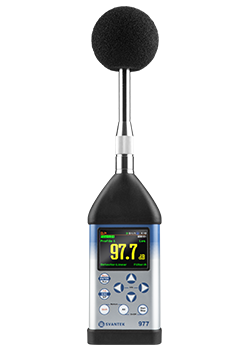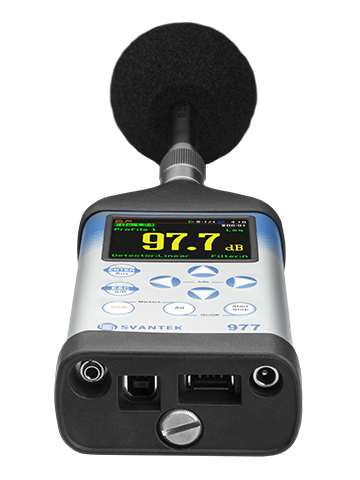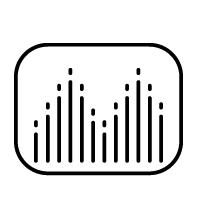
Choosing a Class 1 sound level meter is not just about specifications. Today’s top meters from manufacturers such as HBK, NTi, Rion, Norsonic, and Svantek (SV 971A, SV 977D, and SVAN 979) all comply with IEC 61672-1:2013, hold type approval, and deliver trusted results for professional applications. They share the same core acoustic functions: each model provides a single input channel for precise sound measurements, supports A, C, and Z frequency weighting, Fast/Slow/Impulse time weighting, and offers octave analysis as standard or option.

When selecting a Class 1 sound level meter, focus on:
Broadband measurement range (not just filter range)
Clear definition of linearity and compliance with IEC 61672
Transparent, auditable and understandable documentation
Taking the time to dig into the details ensures your investment delivers not only technical compliance, but practical confidence in every measurement and report.

SV 971A
For everyday professionals who value mobility and battery life
The SV 971A is Svantek’s best-selling sound level meter of all time, thanks to its ultra-compact size and long operating time on standard AAA batteries. This model connects easily to a mobile app, allowing users to view large data sets and reports on their phone or tablet. It’s a favorite among acoustic consultants, health and safety managers, noise policy officers, and is increasingly popular in the audio-video and R&D sectors for its portability. Because of its small size and robust performance, the SV 971A is even used in space missions—proving its versatility far beyond typical industrial or environmental noise surveys.

SV 977D
For those who want versatility, larger display, and occasional vibration or outdoor measurements
The SV 977 features a larger, clearer screen—ideal for users who prefer viewing real-time spectra directly on the meter. Like the 971A, it also works seamlessly with mobile apps, but stands out by offering a unique extended high-frequency range (ultrasound option) and the ability to measure vibration with an IEPE accelerometer. This makes it especially popular with building acoustics consultants and users who occasionally require vibration analysis. With its outdoor case option, the SV 977 is well-suited for unattended outdoor monitoring (including remote access via 4G modem) and can be integrated with automation systems via RS232, making it a solid choice for automated noise monitoring on production lines.

SVAN 979
For advanced professionals, agencies, and R&D needing the ultimate in precision and analysis
The SVAN 979 is the global reference Class 1 meter when it comes to technical specification. It boasts an industry-leading low noise floor (as low as 12 dBA), supports external 200V-polarized microphones, and offers advanced tools for tonality, loudness, and 1/6- and 1/12-octave analysis. This instrument is designed for demanding professional consultants and environmental monitoring agencies who need the most comprehensive analysis suite. The SVAN 979 is often chosen by government bodies and labs because it combines all the features of the 971A and 977, but with broader measurement ranges and virtually all advanced functions activated out of the box, with no extra licensing required.
| Feature / Model | SV 971A | SV 977D | SVAN 979 |
|---|---|---|---|
| Compliance / Type Approval | IEC 61672-1:2013 Class 1 Type approved | IEC 61672-1:2013 Class 1 Type approved | IEC 61672-1:2013 Class 1 Type approved |
| Frequency Range | 5 Hz – 20 kHz | 3 Hz – 20 kHz (sound) up to 40 kHz (ultrasound option) | 3.15 Hz – 20 kHz (sound) up to 25.6 kHz (FFT option) |
| Total Measurement Range | 17 dBA Leq – 140 dB Peak | 16 dBA Leq – 140 dB Peak | 12 dBA Leq – 140 dB Peak |
| Communication Interfaces | USB-C, Bluetooth® | USB, Bluetooth®, RS232, options: GPS, Ethernet, Wi-Fi, 4G | USB, Bluetooth®, RS232, options: GPS, Ethernet, Wi-Fi, 4G |
| Display Size | 1.2″ | 2.4″ | 2.4″ |
| Weight | 225 g | 600 g | 600 g |
All three Svantek meters are fully capable for both indoor and outdoor noise measurements; the key is matching the model to your specific needs.
When choosing a Class 1 sound level meter, it pays to compare total cost, not just headline specs. The price of each meter depends on configuration and options, but the differences reflect both capability and included features:

SV 971A: from €2,500 to €5,000
The best-selling, most affordable option. Even fully loaded with advanced features (like building acoustics or octave analysis), it remains the most budget-friendly way to access true Class 1 performance in a pocket-sized meter.

SV 977D: from €4,000 to €7,000
The versatile all-rounder. The price grows as you add vibration, ultrasound, and automation options—ideal for those who need flexibility to cover both noise and vibration jobs.

SVAN 979: from €7,000 upwards
The flagship platform. Although it’s the highest initial investment, the 979 typically comes with most advanced features pre-installed. For professionals who need the broadest measurement range and full analysis tools out of the box, it’s the most cost-effective “all-in-one” over the long run.
When comparing Class 1 sound level meters for professional or regulatory use with Norsonic, NTI, RION, Bruel & Kjaer or others, it’s essential to look beyond marketing numbers and understand what really matters in practice. Published specifications often use different terminology and measurement conventions, which can lead to confusion—or worse, an instrument that’s not truly suited for your needs.

Frequency Range: Filters vs. True Broadband Measurement
A common pitfall is to take the “frequency range” at face value. In sound level meters, frequency range can refer to two different things:
Why it matters:
For applications like building acoustics, infrasound, or specialized environmental monitoring, it’s vital to confirm that the broadband range—not just the filter range—matches your requirements. Always ask: “Is the stated frequency range valid for wideband Leq and Peak, or just for the spectral analysis filters?”

Dynamic Range and Linearity: Understanding the Numbers
Every compliant Class 1 meter will list a “dynamic range” or “noise floor,” but not all manufacturers present this in the same way. The most reliable specification details:
Why it matters:
For compliance, low-level noise testing, or high-impact environments, knowing the true linear range (not just the absolute minimum or maximum) helps ensure your data is both valid and defensible.

Total Transparency and Documentation
Trustworthy documentation includes:
Why it matters:
Clear, detailed documentation allows you to match the meter to your precise needs and audit your measurements if challenged. This is especially important for regulatory, legal, or consulting work.

Software: Workflow and Cost-of-Ownership
Sound level meters today are as much about data management as hardware specs. Look for:
Why it matters:
A meter that’s easy to integrate into your workflow—without hidden costs or limitations—will save time and reduce frustration over the long term.
An authorized SVANTEK consultant will help You with the details such as the required accessories for your noise monitoring task.